#debris stevenson
Explore tagged Tumblr posts
Text
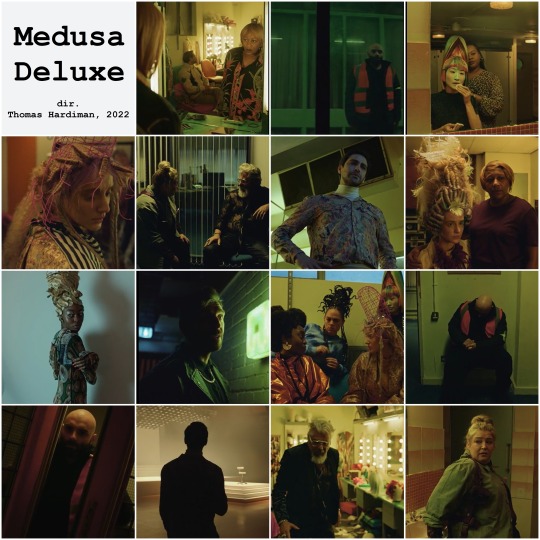
Medusa Deluxe
directed by Thomas Hardiman, 2022
#Medusa Deluxe#Thomas Hardiman#movie mosaics#Clare Perkins#Heider Ali#Kae Alexander#Kayla Meikle#Lilit Lesser#Harriet Webb#Darrell D'Silva#Luke Pasqualino#Anita-Joy Uwajeh#Nicholas Karimi#Debris Stevenson
4 notes
·
View notes
Text
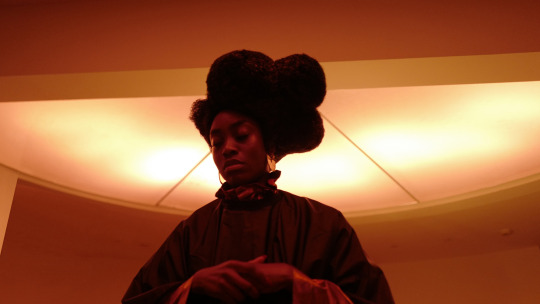
New Trailer | MEDUSA DELUXE (dir. Thomas Hardiman)
"A murder mystery set in a competitive hairdressing contest. Extravagance and excess collide, as the death of a contestant sows seeds of division in a community whose passion for hair verges on obsession. "
Coming soon.
youtube
#A24#Clare Perkins#Kayla Meikle#Lilit Lesser#Debris Stevenson#Thomas Hardiman#Film Trailer#Movie Trailer#Coming Soon#A24 movies#Medusa Deluxe#Youtube
2 notes
·
View notes
Text






Medusa Deluxe (2022) Thomas Hardiman
March 8th 2024
#medusa deluxe#2022#thomas hardiman#darrell d'silva#clare perkins#luke pasqualino#kayla meikle#heider ali#harriet webb#kae alexander#lilit lesser#nicholas karimi#anita-joy uwajeh#debris stevenson#bfi#bbc#mubi
0 notes
Photo

Scam (issue #1) YEAR: 1987 CREATED BY: Sarah Champion, Alison Martin and various contributors LOCATION: Manchester SIZE: A4 WHAT'S INSIDE.... The first issue of Scam features a wonderfully diverse selection of music which includes Manchester house pioneers T-Coy, some hip hop (The Cookie Crew and Beastie Boys), Adrian Sherwood's genre-bending On U Sound label, experimental Welsh language band Llwybr Llaethog (who were championed by John Peel, whose BBC Radio 1 show was still essential listening in the second half of the 1980s), Sonic Youth (the kings and queen of American noise rock, who had recently released their fourth album "Sister") and a few other US bands that emerged in the mid-1980s (Husker Du, Firehose and Swans).
There are ads for Temperance night at the Hacienda and indie club The Venue, which used to be just down the road on Whitworth Street but has since moved to Jackson's Row, as well as three of my favourite Mancunian record shops: King Bee in Chorlton, Piccadilly Records (which is now on Oldham Street but back then was in Piccadilly Plaza where M&S Simply Food is today) and Eastern Bloc (which used to be on Oldham Street but since moved to Stevenson Square). Scam's writers included Steve Barker (host of On The Wire - the most interesting music show on British radio at the time - which always featured a heavy dose of On U Sound) and Dave Haslam, whose main claims to fame in 1987 were DJing at the Hacienda and a fanzine called Debris. Haslam contributes an eye-opening article about Jamie Reid, who designed some iconic record covers and posters for the Sex Pistols during the punk era and had just published a retrospective book called "Up They Rise". The zine also advertises "Head Over Ears" - a compilation LP that came with the sixteenth issue of Debris.
Sarah and Alison's favourite magazines include Viz comic and New Youth fanzine. I really love their fabulously eclectic playlist on page 26 and am happy to say that I've got most of the tracks that appear in it, either on vinyl or CD. Click on the title above to see scans of all the zine's pages.... my box of 1980s fanzines flickr
2 notes
·
View notes
Text
Saisbury Lawns:
The creation of the Salisbury Lawns and the removal of the old formal gardens occurred prior to the arrival of Lancelot 'Capability' Brown at Chatsworth in 1758, most likely in the 1730s.
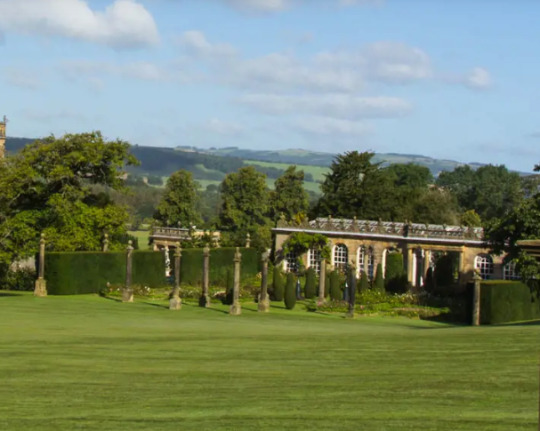
The lawns to the east of the house are known as the Salisbury Lawns, possibly after the plain, and are separated by a long gravel walk that runs east to west from the Cascade to the long Walk. Great Salisbury, the lawn to the north of this route, is slightly under three acres in size. Little Salisbury, the lawn to the south, is slightly over two and a half acres in size. They cover a total of 5.57 acres. Although incorrectly credited to Lancelot 'Capability' in the past, Brown's development of the Salisbury Lawns and dismantling of the existing formal gardens took place before to his arrival at Chatsworth in 1758, most likely in the 1730s during the reign of the 3rd Duke, probably with the suggestion of William Kent. Kent pushed for less formal, more natural garden design. Weather variations have been recorded at Chatsworth more or less consistently since the 18th century. For many years, there has been a 'weather station' on the Salisbury Lawns to satisfy this curiosity in the weather. Every day, the rain gauge is measured and emptied, and the number of hours of sunshine is recorded using a Campbell-Stokes Sunshine Recorder. A little glass sphere directs the sun's rays onto a card attached on the back and positioned on a stand. The burn marks on the card indicate when and for how long the sun has been shining. The Stevenson Screen houses thermometers that record the lowest, maximum, and ambient temperatures for the day.
Canal Pond:
The Canal Pond was dug between 1702 and 1703. It is set a few inches higher than the South Lawn, so when it is viewed from the south end of the pond, the house appears to rise from the water.

Flora's Garden, depicted to the south of the vast parterre on Kip and Knyff's aerial image, was demolished to make way for the Canal Pond. Before the creation of the refrigerator, a 'earthe house' - possibly the ice house beside the Canal Pond - was built and thatched in 1728 and was used until the 1920s to provide ice from the Canal Pond to the house kitchens. Since the pond was excavated, there has been a fountain at the north end of the Canal. The Great Fountain is flanked by two river gods, both of whom are credited to Nadauld. For over 150 years, it was revered for being the highest in the country, reaching 28 metres. It came from what is today known as Morton's Pond. In 1844, the Emperor Fountain, designed by Joseph Paxton, supplanted the Great Fountain as the principal attraction in the Canal Pond. When it became known that Czar Nicholas, Emperor of Russia, may visit Chatsworth the next year, 1844, the Duke was intrigued by the notion of welcome the Czar with a fountain even higher than the one at Peterhof (the Czar's residence in N.E. Russia). Despite the fact that the Czar never visited Chatsworth, the new fountain was named after him. It is known to have reached a height of 90m (300ft). The pressure of water plummeting 122m via a 40cm iron pipe powers it. The fountain received two new nozzles in 2014. One has the same diameter as the original nozzle, but the other is somewhat narrower in order to create a higher column of water, comparable to what Paxton must have achieved. The narrower nozzle, along with a new debris grid at Emperor Lake (which provides the fountain's water), assures the highest flow of water possible, allowing us to reach a height of 60m (200ft).
Casade:
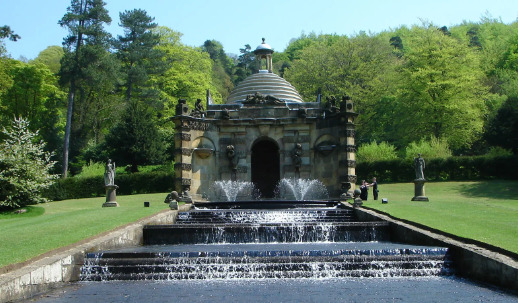
For more than three centuries, the Grade I listed Cascade has been a centrepiece of Chatsworth Garden. Monsieur Grillet, a French hydraulics expert who worked on Louis XIV of France's waterworks, finished the initial design in 1696. Grillet's design was both shorter and more intricate than the one we see now. The water cascades down 24 stairs that descend 60 metres to simulate natural waterfalls. It makes use of rainfall that falls from the east moors and gathers in ponds on the Derwent Valley slope inside the Chatsworth Estate. The Cascade House, or Temple, was built at the summit of the slope in 1702. The Cascade House, designed by Thomas Archer and featuring spouts, fountains and carvings by Samuel Watson and Henri Nadauld, allowed visitors to control the variation and flow of the water, continuing the established tradition of water being used to surprise and delight visitors, one of whom reported in 1725 how jets within the building 'throw up several streams and wett people' (the spouts in the floor are still there). The Cascade was significantly altered in 1713, increasing in length and being broader and steeper than the original. These modifications were most likely the 1st Duke's reaction to the growing influence of French culture on large formal garden architecture. Additional changes were undertaken between 1825 and 1828, when the Cascade was moved to line with the house's South transept and a new gravel road was built up the slope.
It is currently part of a bigger decorative waterworks system. In a marvel of nature-based engineering, water from the moors above the home is channelled down through the forests and garden, powering the Cascade and a hydroelectric turbine on its journey to the river Derwent. The lowest pool of the Cascade immediately feeds the 1st Duke's Sea Horse Fountain on Chatsworth's South Lawn.

First Duke's Greenhouse:
The 1st Duke’s Greenhouse, built in the 1690s, is a long, low building with ten arched windows and is shown in Kip and Kynff’s 1699 view of the garden.
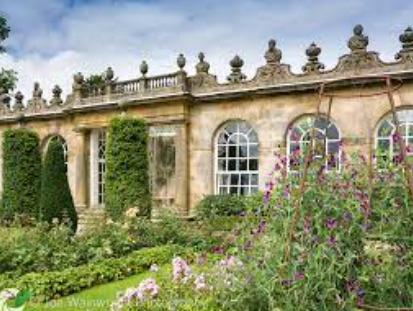
The greenhouse was relocated by the 4th Duke from its original location north-east of the house to the northern border of Salisbury Lawn, where it is now fronted by the Rose Garden. Such structures were initially built in Holland at the beginning of the 17th century and were known as 'greenhouses' because they were originally used to shelter sensitive 'greens', or evergreens, during the winter. They were also known as 'orangeries' since they were commonly used to cultivate citrus species and related plants. The 1st Duke's Greenhouse, which is available to the public, is one of the most significant 17th century greenhouses still standing in England, and it currently contains a portion of our Camellia collection.
Flora's Temple:
Originally called the Bowling Green House, Flora’s Temple was built between 1693 and 1695.
The etching by Knyff and Kip depicts the temple in its original location, beside the Bowling Green to the south-west of the House. In 1750, it was relocated to its current location to the north-east of the house. Flora's statue was created by artist Caius Gabriel Cibber. It used to be in the heart of Flora's Garden, which was located between the south parterre and the border road (where the Canal Pond is now).
Grotto House, Grotto Pond & Morton Pond:
The Grotto was originally constructed in the late 1790s at the instigation of Duchess Georgiana, but was much altered by the 6th Duke in the 1820s.
The Grotto is made of large rocks and features a rectangular chamber ornamented with stalactites (which is not available to the public), which is topped by a rustic timber bandstand with a conical slate roof. The Grotto Pond was presumably built about the same time as Morton's Pond (around 1700) to serve the new Canal Pond. The overflow from the Grotto Pond stream was transformed into a water feature, the 'Trough Waterfall,' in 1992, utilising a series of stone drinking troughs taken from neighbouring fields and agricultural steadings. Morton Pond was once known as the Great Fountain Pond because it served as a supply pond for the 1st Duke's Great Fountain in the Canal Pond. The pipe from Morton Pond to the 1st Duke's Great Fountain became extinct when the Emperor Fountain was built, although it still remains. Duchess Deborah described Morton Pond as 'the least recognised location in the garden where you may sit alone beside the water on the busiest Bank Holiday'. The Drummer (1989-90) by Barry Flanagan is located at the north end of the Grotto Pond and was purchased by the current Duke and Duchess in 2006 to celebrate their move to Chatsworth.
Ring Pond:
The Ring Pond is a survivor from the 17th century gardens. It originally lay in the middle of a formal plantation of trees, with the Willow Tree Fountain at its centre.
To the right of Kip and Knyff's overhead perspective, you can see the original location. The herms (stone busts on columns) were designed in the 18th century by William Kent and were only installed here in 1893. They used to be in the gardens of Chiswick House in west London.
South Lawn & Sea Horse Fountain:
The south parterre began construction in 1694 under the guidance of George London and Henry Wise, who also worked at Hampton Court Palace. The parterre was a pattern of intricate flower beds, hedges and gravel paths.
The 1st Duke was among the first Englishmen to succumb to the excessive design of formal gardens, which was already popular in France, Italy, and Holland in the late 17th century. Caius Gabriel Cibber sculpted the Seahorse Fountain, which still stands in the midst of the South Lawn, between 1688 and 1691. Water flows into this fountain from a conduit at the foot of the Cascade. The force for the show here is provided by the pressure created by the 50-foot drop. The fountain was recently repaired and restored before being returned to Chatsworth in the summer of 2015. Francesco Bienaime created the eight Carrara marble sculptures and two urns between the pleached limes for the 6th Duke in the 19th century.
Willow Tree Fountain:
The Willow Tree Fountain was an ‘artificial tree of brass’ originally created by Ibeck in 1695. It was first in the centre of the Ring Pond and has been remade twice.
Celia Fiennes (1662-1741), a pioneering traveller, stated in 1696, 'all of a sudden by turning a sluce it raines from each leafe and from the branches like a shower, it being made of brass with pipes to each leafe but in appearance looks perfectly like willow'. The current fountain is a replica from the early nineteenth century that was built to replace the original, which had deteriorated. Bowers of Chesterfield, who worked for the 6th Duke, created it. The Willow Tree Fountain was given a new lease of life in 1844 when it was relocated to the Rockery's northern border, in a little glade behind a group of Paxton's rocks.
Arboretum and Trout Stream:
The Arboretum, started in 1835, was one of Paxton’s greatest contributions to the Chatsworth landscape; a systematic succession of trees in accordance with botanical classification.
youtube
The new Arboretum took up most of the previous eastern section of the pleasure grounds. It was a massive undertaking that included, among other things, diverting a natural stream for more than two miles along the Trout Stream from its original path on the East Moor in order to create a suitably attractive feature in the design. The Arboretum is now a component of the garden's broader Trout Stream section. The Trout Stream inspired the Laurent-Perrier Chatsworth Garden at the RHS Chelsea Flower Show in 2015. We are thrilled and honoured to have won Best Show Garden at the 2015 RHS Chelsea Flower Show. The garden, designed by Dan Pearson and constructed by Crocus, captures the spirit of Chatsworth, borrowing inspiration from Sir Joseph Paxton's 19th century decorative Trout Stream and reinterpreting parts of this intimate feature. The garden also included features of Paxton's Rockery, such as a rock wall and rock stacks fashioned from Chatsworth gritstone. The landscaping, which embodies the "lightness, freshness, and delicacy" of Laurent-Perrier, includes azalea, Rhododendron loderi, native woodrush, and numerous ferns brought straight from Chatsworth. The plants and rocks used in the exhibition garden, as well as many of the other plants, seats, decks, and the enormous oak sculpture, arrived at Chatsworth in fall 2015. These have already been erected and planted along the Trout Stream, with further planting planned for 2016.
The Case:
The Case acts as a protective cover for the tender plants grown here. Originally called the Conservative Wall, it was designed by Joseph Paxton in 1838.
The Case is supported by a clever system of flues and hot-water pipes that keeps the temperature high enough in the winter for half-hardy plants to thrive. Originally, there were protruding wooden panels from which canvas curtains could be hung in inclement weather, but Paxton covered it with a wood and glass frame in 1848. The 91-meter-long tower shields figs, peaches, nectarines, apricots, and other bushes from the unpredictable Derbyshire environment.
Coal Hole & Tunnel:
Horse-drawn carts brought coal from the railway station at Rowsley, entered the garden above the stables, and took the track that went under the Cascade and on to the Coal Hole.
The Coal Hole is located to the north-east of the Great Conservatory, away from the main road through the Rockery. Once at the coal pit, the coal was transported in miniature waggons down the subterranean railway. Although the Coal Tunnel's exit was always open, there was a barrier farther up the tunnel. In 2002, shooting at Chatsworth prompted an exploratory excavation to determine the cause of the obstruction. The Coal Tunnel and Coal Hole have been filled up with garbage, including plants and pots, since the Great Conservatory was demolished. The tracks were removed once the tunnel was dug, and railings and lights were built. The Coal Hole and Tunnel was opened to the public in 2003.
Great Conservatory:
Paxton’s Great Conservatory took four years to build and was completed in 1840.
The notion was broad. Before the construction of Paxton's later miracle, the Crystal Palace in London in 1851, the structure was 84m long, 37m wide, and 19m high, making it the biggest glass building in England. There was enough room inside for two carriages to pass on the main highway, and stairs covered by climbing rocks led to a gallery from which you could observe the tallest branches of the exotic palms and other plants that flourished there. In a tropical environment, there were ponds full of aquatic plants, rocks, mosses, ferns, and brightly colourful flowers. There were eight subterranean boilers powered by coal that arrived through underground train waggons to generate this atmosphere. From the Coal Hole entrance, a brief section of the tunnel is currently exposed. The boilers supplied hot water to a seven-mile network of 6-inch hot water pipes. In the winter, 300 tonnes of coal were required to fire the boilers. The boiler fumes fled through ground-level flues to a chimney high in Stand Wood, well out of sight of the garden. There wasn't enough coal to heat the conservatory during and after World War I (1914-18), thus many plants died. Due to the high cost of reconstructing the now-derelict structure, as well as the high cost of maintaining and heating it, the Great Conservatory was demolished in 1920, leaving just the supporting walls as a permanent testament to this amazing structure. The Maze was founded by the 11th Duke in 1962 within the walls of the ancient Great Conservatory.
Pinetum:
The Pinetum was created between 1830 and 1831, established from eight acres added to the garden from the south park (The Old Park). Here, the 6th Duke and Paxton indulged their passion for collecting on a grand scale.
In the early to mid-nineteenth century, significant developments were taking place in British gardening. Gardens grew in intricacy, scale, and importance, and there was a rising interest in scientific horticulture during the period. New plants from the Americas, Africa, and Asia had been arriving in greater quantities in Britain during the 18th century, but scientific plant-hunting trips, many of which the Duke financed, were suddenly becoming more popular and successful. This was one of England's earliest pinetums, or groupings of coniferous trees. It had Lebanon cedar Cedrus libani, Douglas fir Pseudotsuga menziesii, Norfolk Island pine Araucaria heterophylla, a huge redwood Sequoiadendron giganteum, monkey puzzle Araucaria araucana, and Japanese white pine Pinus parviflora in it. David Nash created the artwork 'Forms that Grow in the Night' specifically for this place in Pinetum's south-east corner in 2009.
Rock Garden & Strid:
The Rock Garden was built as a reminder of the 6th Duke’s visit to the Alps during the Grand Tour of Europe. Work began in 1842 and the stone was brought from Dobb Edge, north of Stand Wood.
The Wellington Rock, the tallest structure, is about 14 metres high and has a waterfall cascading down it. A network of trails winds around and beneath the rocks. Work on the Bolton Stride or Strid, a shallow gap filled with a flowing stream and encircled by further rockwork, also began in 1842. This was inspired by an actual feature on the Duke's Bolton Abbey estate in Yorkshire, a chasm formed by the River Wharfe. Wild currants, bilberries, and other plants transported from Bolton Abbey were planted around the rocks. The largely collapsed upper rockery was partially restored in 2002-3. Simultaneously, a platform with views west over the Strid, over the Ring Pond and Serpentine Hedge, and into the park beyond was built. The current Duchess planted a selection of dark or black flowers in the Dark Side area near the northern entrance to the Rock Garden in 2007. Since 2018, we have started redesigning the Rock Garden to give better access as well as mass perennial planting for summer appeal.
Vinery:
Built circa 1834, this is the sole survivor of three glasshouses constructed specifically for orchids by Joseph Paxton. It contained the 6th Duke’s superb collection, gathered from all over the world.
Several orchids in the Vinery were named after Chatsworth, Paxton, or the Duke, for example, Coelogyne cristata Chatsworth, Dendrobium paxtonii, and Stanhopea devoniensis. It presently holds white peaches, camellias, and our Royal Horticultural Society prize-winning Vitis Muscat of Alexandria dessert grapes, which were largely planted in the 1920s.
youtube
Cottage Garden:
The Cottage Garden was created in 1989 with topiary 'rooms' and 'furniture' created out of box, privet and yew hedges. The Cottage Garden has a formal ‘front garden’ and a pair of vegetable plots at the back. These are planted by Chatsworth’s two annual trainees as part of their education.
Ravine and Azalea Dell:
In the early 1930s, Duchess Evelyn, in collaboration with the head gardener, J. G. Weston, created a new feature in the garden inspired by the latest 'woodland garden' fashion. The Ravine and the Azalea Dell were built in the early 1930s by Duchess Evelyn in conjunction with the head gardener, J. G. Weston. These planting sections were obviously in the 'woodland garden' style advocated by famous horticulturists William Robinson and Gertrude Jekyll, who preferred 'wild' or 'natural' gardens to traditional formal gardens. A creek was dammed at various points to form many ponds. Primula, ferns, meconopsis, berberis, viburnum, buddleja, and rhododendron were planted. The rhododendron on the 'cliff-like side' was left alone, save for a tiny walkway carved through them and accessible by a wooden bridge over the top half of the valley. This region was neglected during WWII but was substantially restored by Duchess Deborah in the 1980s. More work in this region has recently been completed. In numerous spots, the walkway now meanders across the stream, and the pools have been expanded. All of the Rhododendron ponticum has been removed as a precautionary measure to prevent the spread of Phytophthera ramorum. As a consequence, the Ravine's 'cliff-like side' was replanted in 2013. The bushes in the Azalea Dell put up a spectacular show twice a year. The thick mass of Double Ghent azaleas and Rhododendron luteum combine to give a strong perfume in late May, and the leaves colour quite beautifully in the fall.
Rose Garden:
Originally the French Garden, in 1939 Duchess Mary, wife of the 10th Duke, remodelled this area and it became known as the Rose Garden.
Following his ascension in 1811, the 6th Duke created a new parterre to the south of the 1st Duke's Greenhouse. Flora's statue, sculptures from Carnac's temple, and a 'white cistern…from Carrar' adorned it. So the basic layout of the garden was developed, and it was christened the French Garden. Duchess Mary, the 10th Duke's wife, rebuilt this area in 1939, and it became known as the Rose Garden. She planted hybrid tea roses and surrounded it with a yew hedge. Almost all of the statues and ornamentation have been relocated. The centre stone bed is now a fountain in the house's inner court, as are the stone pillars. The four middle flower beds are planted with White Phlox, which blooms later than roses and so extends the season of appeal. The flower beds in front of the First Duke's Greenhouse are home to a variety of tree peonies, which bloom from April until mid-June and were introduced by Duchess Deborah. Because the stone border of the Rose Garden had grown so uneven, a small group of our garden volunteers painstakingly removed and re-laid it in 2011. It is now straight and level, a result of their hard effort.
Serpentine Hedges:
In 1953, the Serpentine Hedges were created, an idea which Deborah Duchess took from the ‘crinkle-crankle’ wall at Hopton Hall near Wirksworth. At the same time, the circle of beech hedging around the Ring Pond was planted.
Display Greenhouse:
This greenhouse is sited to the north of the First Duke's Greenhouse and has three climate zones: tropical, Mediterranean and temperate.
The temperate and Mediterranean zones were initially offered to tourists in 2011. To minimise heat and humidity loss, the tropical zone is closed to visitors. We are building a collection of plants that have been cultivated at Chatsworth for over 400 years in the temperate zone, which is regulated at a minimum temperature of 4°C. Each bed will represent a different era; one will represent the period between Bess of Hardwick and the 1st Duke, the second will represent the 6th Duke and Joseph Paxton, the third a small collection of what the 11th Duke and Duchess built the Display Greenhouse to house, and the fourth will feature some of the 12th Duke and Duchess' favourite plants. Oranges, lemons, limes, and loquats flourish in the Mediterranean zone, where the minimum temperature is 13-16°C, and are utilised in some of the items available at the estate farm store and kitchens. There is also a night flowering cactus, Epiphyllum species, that develops masses of blooms 30cm wide for only one night twice or three times in summer. A Citrus limon Imperial may be found at the extreme left part of the Mediterranean zone. This hybrid of lemon and grapefruit produces enormous yellow fruit. The Imperial lemon is used to produce marmalade in the house. In the Royal Horticultural Society Autumn Fruit and Vegetable Competition in 2012, it took first place in the Miscellaneous Glasshouse Fruit category. Two banana plants, Musa acuminata Dwarf Cavendish, are assumed to be stock from the original plants Paxton managed to fruit in the extreme reaches of the tropical zone (maintained at 16°C and higher). This was introduced from Mauritius in 1829, and it thrived at Chatsworth, prompting Joseph Paxton, the 6th Duke's chief gardener, to send one to a missionary in Samoa, where it thrived. It is currently produced commercially all throughout the world, and the bulk of the bananas consumed in the UK each year are Musa acuminata Dwarf Cavendish. A massive water lily may be found in the centre pond. Paxton had brought one from Kew Gardens, where it had not bloomed. In 1849, he succeeded to get it to blossom for the first time in the United States in a specially built lily house (since demolished). It is an annual that continues to develop rapidly in the pond in this greenhouse's Tropical zone. The lily is propagated in our glasshouse using seed taken from the previous year's plants.
youtube
The Maze:
Originally the site for Paxton's Great Conservatory, this garden is now home to a large yew maze.
The Maze was designed by Denis Fisher, then Comptroller, in 1962 for the 11th Duke and required 1,209 English yews, Taxus baccata. Flower beds were set out at each end of the Great Conservatory's surviving walls in the 1920s, with walks running through and around them. The plants have changed, but the beds have not. Russell hybrid lupins, Lupinus Russell Hybrids, are planted in the four centre beds at the north end, and late summer and fall flowers are put in the gardens that surround them. Outside gardens at the south end are planted with Michelmas daisies and Aster. The inner beds are planted with tulips in the spring and dahlias in the late summer until the frosts arrive. The Hundred Steps were designed in the 1980s. This long, straight rise runs upward from the Maze and is aligned with the Maze's core. It is broken up halfway by a lone monkey puzzle, which has been left as a dramatic event in the view by the clearing of the surrounding jungle. The Greek Altar, unearthed during clearance work in the mid-1980s by then-head gardener Jim Link and his crew, has been placed at the top of the stairs on the Arboretum Walk to urge people to pause and gaze west, over the Maze, to view the park and surrounding woodlands. After seeing one in a magazine, Duchess Deborah had a human sundial placed at the north end of the Maze in 1990.
Kitchen Garden:
Chatsworth has grown its own food for centuries and all manner of fruit, salad, cut flowers and vegetables are grown in the Kitchen Garden.
The 11th Duke and Duchess Deborah established the contemporary Kitchen Garden in the late 1980s. However, gardens providing food for the house have existed all across the estate for about 500 years. The first Duke most likely planted fertile gardens in 1549. The third Duke erected walled gardens in the mid-1700s, and variants of them were utilised until the 1900s. The modern Kitchen Garden may be found east of the stables. This area was previously known as the Paddocks because it was where carriage horses were put out to graze. The greenhouses were already there, but it was a bleak, featureless plain until the early 1990s. The 11th Duke and Duchess Deborah believed that the renewed interest in producing fruits and vegetables justified an investment to make the area more fascinating and accessible to everybody. It was built throughout the winters of 1991/2 and 1992/3. Drains were installed, raised beds were constructed from old bricks, and some new walks were edged with railway sleepers. Fruit trees were supported by iron arches. Mummy peas, supposedly cultivated from peas unearthed in Tutankhamun's tomb in 1922, are among the many fruits, salads, cut flowers, and vegetables grown here. The kitchen garden provides vegetables for the home, and any excess is sold in the stable yard and farm shop. A little orchard is beyond a beech fence in the lowest section of the property. We cultivate a variety of Derbyshire-bred fruits here, including the apple cultivar Beeley Pippin.
Snake Terrace:
In 1974, the Snake Terrace was constructed in the space between the First Duke's Greenhouse and the Display House. Like the Maze, the Snake Terrace was designed by Denis Fisher (the then Comptroller), using wedge-shaped stone taken from Paxton’s old Lily House, and with the serpent motif (the crest of the Cavendish family) picked out in pebbles taken from the beach at Eastbourne. The terrace was linked to Paxton’s Case by the Laburnum Arch (1974) which from late spring is a mass of yellow scented racemes. The leaves, flowers and seeds of laburnum are poisonous.
Sensory Garden:
The idea for the Sensory Garden was instigated by Lord Burlington, the 12th Duke's son. The Sensory Garden was created in 2003 at the instigation of Lord Burlington, the 12th Duke’s son, with plants which were chosen for their impact on the five senses – sight, smell, touch, hearing and taste.
Quebec:
In 2008, the 12th Duke and Duchess re-established Quebec, a long-over-grown area below the Canal Pond. The 9th Duke may have named this area on his return from being Governor-General of Canada. When this area was cleared, a cascade dating from the early 1700s was revealed. Déjeuner sur l’Herbe, by the sculptor and artist Allen Jones is situated at the south end of Quebec.
Summer House and Golden Grove:
Near the Summer House is a plot planted in gold and yellow – the Golden Grove. All the shrubs and small trees here were given by friends and neighbours of the 11th Duke and Duchess to mark their golden wedding in 1991. Holly Walk, the path above the Summer House, has several hollies that were planted after the rhododendron bushes were removed. Ilex aquifolium Flavescens, Madame Briot, Bacciflava, Silver van Tol, Ferox Argentea, and Handsworth New Silver are planted in large groups, with Araucaria araucana from Monkey Puzzle intermingled. Deborah Duchess put seventeen of them from seed amid the hollies, and many are still growing. Deborah Duchess characterised the Summer House as "a hideous building of the Bachelor Duke's." 'Here is, or ought to be,' he wrote. The style is Saracenic; the columns are of Aberdeen granite, and the rough central capital of serpentine arrived with me from Palermo, and is the source of this form of decorating.' Malus x zumi Golden Hornet, Gleditsia triacanthos Sunburst, Acer shirasawanum Aureum, Rhododendron Haida Gold, R. Golden Wedding, Spiraea x japonica Goldflame, and Spiraea x japonica Gold Mound are among the plants planted in the Golden Grove. Shrubs that bloom in the winter and early spring above the Golden Grove include Mahonia, Hamamelis, and Viburnum x bodnantense.
1 note
·
View note
Text
Medusa Deluxe | Official Trailer HD | A24
From writer/director Thomas Hardiman and starring Clare Perkins, Kayla Meikle, Lilit Lesser, and Debris Stevenson. MEDUSA DELUXE – Coming Soon. Do escritor/diretor Thomas Hardiman e estrelado por Clare Perkins, Kayla Meikle, Lilit Lesser e Debris Stevenson. MEDUSA DELUXE – Em Breve.
youtube
View On WordPress
0 notes
Text
Treason: The Musical Meta: The Ladies
So, before the full recording was released, one of the things I was most curious about was how the female characters would end up being treated -- would they be on the periphery, or would they be characters in their own right? Most of the early releases, with the exception of Blind Faith and the Day That Elizabeth Died, were centered around the male characters. It seemed like they would get the most focus, especially since....the Gunpowder Plot is pretty much exclusively known for the male conspirators, especially Guy Fawkes. I wasn’t overly optimistic from the cast list dividing the cast into “The Plotters” and “The Peacekeepers”, with the only female character NOT being put into “The Peacekeepers” being Debris Stevenson as the Narrator -- it gave the idea of a gender binary where women = peaceful, non-violent, and non-assertive, while men = violent, assertive, and aggressive. Martha seemed like she was going to be important, but was she just going to be one more female character whose role in the story was to be The Wife™?
(Spoilers beneath the cut)
I was really shocked when I got to listen to the full album (thus far), and realized that, in the full musical as it stands, this is Martha Percy’s story, her tragedy. Yes, she still is shown to be against the plot repeatedly, as opposed to her husband Thomas, who is pulled into religious zealotry by his crush Robert Catesby, but it’s grounded, imo, in a way that a lot of similar characters aren’t. We open and close the musical with her grief, with a kind of brilliant subversion in the sense that the folk song used as the basis for her opening/closing solo, “Cold Blows the Wind”, is actually about a young man who is grieving his lover. (I will note, in the interest of objectivity, that there have been a number of female performances over the years, including some which changed the lyrics.) We see how much of a toll this is taking on her marriage, she’s allowed to vent her worry (A Watchful Eye, Blind Faith) her self-doubt and confusion and guilt (The Inevitable), her anger and frustration (No Happy Ending) in a way that feels really organic and makes her feel more like a rounded character. A lot of reviews say that they’ve gotten rid of Guy Fawkes to focus on the tragedy of Thomas Percy, but I don’t really think that’s the case, or at least. Not the total truth. I think they got rid of Guy Fawkes to focus on the tragedy of Martha Percy.
I also appreciate that, while none of the other female characters are given the same level of fleshing out, we absolutely see they aren’t a monolith -- with the final decision at the end, some of the women want to support the men in the plot, arguing that they’re fighting for Catholicism in a time where they’re being persecuted, while others argue that the guilt of hundreds of innocent lives on their hands would haunt them. It isn’t a simple matter of “women = peacemakers”, but something that they have to work through. Likewise, in “The Day That Elizabeth Died”, instead of splitting the final minute or so between the women and the men, with the women singing “We mourned for her/She was our Queen/And for forty five years/She had reigned supreme” and the men singing “We did not mourn for her/She was our captor”, in the new version, while the women do sing the first verse, they ALSO sing the second, along with the men. It makes sense -- it’s possible to mourn the stability that someone brought, even as they were a pretty terrible person whose reign included some pretty terrible things, and it’s natural for there to be divided feelings.
Going back to the final couple of songs in the musical, I find myself going back to “Caught in the Crossfire” repeatedly, not even because the tune is my favorite in the musical (that honor PROBABLY goes to “Burn” or “No Happy Ending”), but because it’s, imo, brilliant in how it resolves that question: Who sent the anonymous letter to Parliament? I know there are a few candidates, people have argued and back forth, but it is interesting, when you think of it, that the main suspects are always assumed to be men. The musical plays on the same ideas that we all had going in, that this is a story about men, that women are there to be Shrews or Obedient Wives, to deliver its coup de grâce. We don’t expect it, because we’re conditioned to not expect it, especially from women like devoted, uxorious Martha Percy.
I think it might be a little too on the nose in her monologue, especially since I always feel...when we talk about how men go to war and women are left to clean it up...how many women DID go to war and we just didn’t want to talk about it? It reminds me of how there was a certain blogger who once said that men in the French Revolution participated in the Revolution while the women kept the memory of the events alive...which works well until you remember that some of those women’s participation was deliberately muted in the memoirs, either as the result of self-censorship after the fact (like Grace Dalrymple Elliot’s work as a Royalist spy) or by their biographers as a means of forcing them to fit within a certain ideal. You know, it’s easy to fit people on that kind of paradigm when that’s deliberately the paradigm they wanted us to believe actually happened. I can also see how a woman like Martha Percy could believe that, from where she’s at, but this monologue feels like it’s for the benefit of the 21st audience, so I go back and forth, likewise for the women deciding to do it “for the women of history” -- I felt like their reasons were perfectly plausible, and perfect for them as characters -- I don’t think they need to see it as a broad feminist decision in order to do it; they have agency either way. But, that being said, while the monologue does feel a little bit modern and out of place, it does remind me a lot of the original meaning of “Well behaved women rarely make history” -- that the women who lived their lives, day to day, supported their families, did their daily chores, are often left out of history books, rendered boring or not worthy of study or consideration. So I’m of two minds on it, I see areas it works and areas it doesn’t. But I think that, overall, the treatment of its female characters, especially Martha, was so much better than I thought it would be going in, I think there are things it does with the female characters that are honestly brilliant, and I look forward to seeing where else it might go.
1 note
·
View note
Link
0 notes
Text
Treason the Musical in Concert Review: The fuse is lit but the flame is yet to burn brightly
I originally wasn't going to post anything about @TreasonMusical because, well, I was not invited to review it 🤷🏼♂️ But I had an awful lot of thoughts about it as an exciting new piece of musical theatre and how it can be refined as it moves forward
The first live performance of the musical based around the iconic events of The Gunpowder Plot shows great promise, but is far from complete (more…)

View On WordPress
#Bradley Jaden#Carrie Hope Fletcher#Cedric Neal#Daniel Boys#Debris Stevenson#Hannah Chissick#Kieran Lynn#Les Dennis#London Musical Theatre Orchestra#Musical Theatre#Musical Theatre review#Ricky Allan#Simon Anthony-Rhoden#Treason The Musical
6 notes
·
View notes
Text

AAAAAAAAH
#BRADLEY JADEN!!!!!!!#I LOVE HIM#no hadley though :(#treason the musical#treason the musical in concert#Lucie Jones#Rebecca LaChance#Sharon Rose#Debris Stevenson#oliver tompsett#Bradley Jaden#Waylon Jacobs#Emmanuel Kojo#Daniel Boys#Cedric Neal
20 notes
·
View notes
Text
I just switched on & flicked my #radio
AND
I've just heard #AMAZING #POETRY
by poet
Debri Stevenson(?) on #BBCRadioLondon,
just before
@sunnyandshay
tonight Friday November 15, 2019; WOW!
#ListenAgain; and of course, don't miss our #friends #sunnyandshay!
I'm Crazy,
so the spelling may be wrong, but Debri's cadence is #superb!
(..no pressure
under pressure
West London stylee; all night long! )
AND of course, the brilliant chat show
by
Sunny And Shay!
( 🎂 happy birthday to your daughter. 🎂)
from #CrazyBengieFB
--------
#debri stephenson#poetry#sunny and shay#sunnyandshay#radiolondon#radio london#poet#spoken word#crazybengiefb#edit by crazybengiefb#leopard klan#leopardklancrazy#leopard klan crazy#beautiful poem#debri stevenson#london poet#artists on radio#arts & culture#amazing poet#edits by crazybengiefb#maybe i'm amazed#debrie stephenson#london
0 notes
Text
Saturday Morning Session
(personal commentary in italics) (sorry for how inconsistent i am at this, i’m trying new medication, so my focus comes and goes unpredictably, but i didn’t want this to take weeks)
Russel M Nelson - strengthen your testimony (?)
"I understand better what he meant when he said 'behold, i will hasten my work in this time.'"
Y'all have been strengthening your testimonies and i, and your children, thank you. did that inclusion of "your children" feel off to anyone else?
I can see the work on the temple outside my window and that makes me think about how we need to remove the old debris from our lives. I too think of the temple as 'old debris' that should be removed from my life.
"the gospel is a message of joy" I cannot roll my eyes hard enough
that was short. what was the topic? blab for a five minutes?
Dieter F. Uchdorf - god is Among Us
I had to move lots when I was a kid because there was a war on. i thought about the missionaries who came to the country of their enemies to bring us the gospel.
i was a kid in a war-torn country > missionaries > god has not forgotten us > we will be heirs of god > how could we complain when we have that? > the atonement > mistakes are okay, just gotta keep repenting.
what would jesus teach if he was among us today? the same thing he's always taught. "the savior always teaches timeless truths, to everyone, a message of hope and belonging, a testament that god has not abandoned his children that god is Among Us."
jesus says to love one another and to be full of charity towards all men. i would like to see it.
anyone else feel like these talks are just. empty? like, they're not feeling it either?
if jesus came into your home today, he would see into your heart and i'm gonna waste a couple more minutes by expanding on that. one look into his eyes and we would be forever changed by the realization that god is Among Us.
back to me, i wish i could go back and tell myself to stay on the right track because god is Among Us, so i'm gonna tell you instead. god is Among Us.
"line upon line" *gag*
god is Among Us
Joy D Jones - abuse is wrong unless you use it to teach kids about the gospel
"have you ever wondered why we call 'primary' 'primary'?" as someone who understands how language works, no.
because kids are importanter than everything else
god trusts us to be nice to our kids; that means no abuse, even if we're angry. whoever needed this reminder should be shot.
hey, maybe you can "combat the evils of abuse" by not fucking raising your kids in an abusive cult!
analogy of a kid who fell out of bed because he "didn't get far enough in" = he wasn't indoctrinated enough, with awkward collage of pics of kids for a minute.
eyring said to get 'em while they're young
love all the pics of black people that try to say "see? we don't think black people are inherently evil (anymore)!"
analogy of a soldier in boot camp. drill seargants are mean, but that was necessary because apparantly it's the only way this guy can learn how to hide. also, apparently this guy is "our friend". not my friend, thanks.
"how can we do the same for our children?" don't fucking act like a drill seargent to your kids! ffs
"wouldn't we rather have them sweat in the safe learning environment of the home than bleed on the battlefields of life?" first of all, fuck you. second, dramatic much? third, fuck you, kids shouldn't have to learn about life in a hostile environment. does this woman have kids? are they okay? fucking hell, five kids were raised by a woman with this mentality. what a bitch.
"eternity is the wrong thing to be wrong about." i got news for you. of course, if i ever spoke to this machine, that topic wouldn't be my top priority.
I need a fucking drink.
Jan Eric Newman - teaching the gospel is good, but you can't force a testimony on others
anecdote about a local old woman getting birthday gifts. she taught us some good things when we were growing up, so thanks, sister davis.
another teacher, at college, was a "master teacher." he loved me and the lord. he taught me to learn doctrine on my own and that "changed me forever."
just sayin', if you're taught how to learn on your own, but didn't exercise enough critical thought to gtfo of this cult, maybe the teacher wasn't the best.
it's good to have good teachers.
the ancient nephites and lamanites had good teachers, and "there was no contention among them!"
"how can we teach more like the savior and help others become more deeply converted?" nope, nope. nope.
1st, "learn all you can about the master teacher hismelf." so, we're sticking with the term "master teacher." cool. doesn't sound weird at all.
ask yourself questions about how he taught, then do that.
read "teaching in the savoir's way."
2nd, use bullshit stories. oh, no, it's a story about how somebody is grateful for the pandemic because her adult child read the BoM for the first time during it. she said it had made "literal miracles."
3rd, "remember that conversion must come from within." guess jan and "joy" should have compared notes before speaking.
"children inheret many things, but a testimony is not one of them. we can't give our children a testimony any more than we can make a seed grow; but we can provide a nourishing environment, with good soil, free of thorns that would choke the word."
Gary E. Stevenson - kindness
story about a study where rabbits were fed a high-fat diet, but those under the care of a loving researcher didn't gain as much weight.
only christians can intuitively understand that this means there's a reason to be kind to others.
jesus said love one another.
addressing primary kids - be kind. here's a story about a kid who stopped being a bully because the bullied kid said it hurt.
to the teens - social media makes bullying worse, clearly satan is using social media against your generation. do what you can t make these spaces safer. if you're a bully, "stop it."
to the adults- "we have a primary responsibility to set a tone and be role models of kindness (get wrecked "joy"), inclusion and civility."
from ballard- "i have never heard members of this church to be anything but loving, kind, tolerant and benevolent to our friends and neighbors of other faiths." k, but, like, you know it's not just a difference of religious belief that’s the problem, right?
i'm heartbroken to hear about prejudice against blackasianlatino people or of any other group. i love how that section was really only about race, with a blanket "any other group" thrown in as an afterthought so they can't be accused of being homophobic.
in the winter of 1838, jo smith was in prison and why do you think that happened, gary?
church members were driven from their homes and the residents of a town across the river gave them food and shelter. that generosity saved the lives of many of them.
god is a compassionate care-giver.
Gerrit W. Gong - disjointed anecdotes of human experiences, idk
i miss my dad. he was adventurous, except regarding food.
i saw a guy be mean to a lady selling ice cream. he smashed all of her cones. the image of her trying to salvage the cones haunts me to this day.
story of the good samaritan.
be like christ this easter.
"we recieve inspiration as we counsel together, listening to each person, including each sister and the spirit."
does this guy have a topic?
he’s is just giving a list of random human experiences and parables.
*displays a lack of understanding of instagram.*
he's listing something throughout this, like, he keeps counting, but i have no idea what and his voice is making my adhd medication run away, so i'm not listening to this again.
Henry B. Eyring - temple worthiness
today i'm feeling light and hope, like the first day i went to the salt lake temple
i'm an oblivious fucker who didn't notice my name being pinned on me, so i thought the woman who greeted me was an angel because she knew my name.
thought he could remember being in the temple before, but a voice that was not his own (that's how you know it's true and not something he just told himself) told him he was remembering heaven.
confused "holiness to the lord" with "this is a holy place." i know both phrases use the word 'holy', but like, those contexts mean separate things.
i also had this feeling during my wedding in the logan temple.
i think henry should get checked out, he suffers from frequent hallucinations and it's good to know how your brain works differently from others when in a leadership position.
during my wedding, i had a vision of a house and the officiant said to live in a way that you can walk away easily. a year later, my father in law bought the exact house and my wife and i lived in the guest house for ten years. then i got the call to move somewhere else on assignment from the church and we walked away easily.
scripture from jesus about temples.
if you're unworthy in the temple, you won't be "able to see, by the power of the holy ghost, the spiritual teaching of the savior that we can recieve in the temple."
"when we are worthy to recieve such teaching, there can grow, through our temple experience, hope, joy, and optimism throughout our lives. that hope, joy, and optimism are available only through accepting the ordinances performed in holy temples."
i forgot how simple a baptism is, so i'm gonna tell you how amazed (and a little concerned) i was when my youngest daughter stayed to do baptism for the dead for all of the names on the list that day. maybe i'm just super comfortable in the water, but that doesn't sound hard, actually. i used to almost enjoy doing those.
quotes the primary song 'i love to see the temple.'
remember to be worthy so you can live with your family forever.
#exmo#ex mormon#exchristian#ex christian#excult#cult stuff#exlds#ex lds#former mormon#apostake#ex religious#agnostic#mine#gc april 2021#gc summary
8 notes
·
View notes
Text
John James Stevenson, Report of Progress in the Greene and Washington District of the Bituminous Coal-Fields of Western Pennsylvania, 1876
Page 99: No other openings were found in this portion of the township. On the Davistown road near the Greene township line, the hills rise nearly 300 feet above the Waynesburg, but without affording any exposures. The Waynesburg “A” is not exposed in this interval indeed it was not seen in this portion of the township. As one approaches Davistown, descending the east fork of Meadow run, he sees at the first fork in the road above that village, a slight blossom which probably belongs to this coal. That is the most south-easterly exposure of the bed. At Davistown the Waynesburg is mined somewhat extensively for local use, and the following sections were obtained at the opening back of the steam mill… Page 126: At one time the Waynesburg was mined here by Mr. W. Flenniken, but the opening has been deserted and no definite information can be secured respecting the coal. Following up the creek; the Uniontown Coal is exposed earn the first fork in the road, where it rests as usual upon a bright ferruginous limestone and is about three feet thick. AS far as one may judge from the blossom alone, it seems to be coal of fair quality, but no openings have been made upon it to test its value. In the immediate vicinity, the Waynesburg is seen in the hill at 95 feet above the Uniontown, and three-fourths of a mile north at the forks in the road. The Waynesburg “a” is shown apparently two feet thick. Page 150: At the first fork in the road ascending this run, limestones V and VI are exposed in a little bluff at twenty-two feet apart. The former is course and breciated on top, but the lower layer is probably good enough to make a strong lime. The Upper Washington limestone, VI, shows the characteristic snow-white surface and the flesh-colored interior. It is seen in the bed of the east fork at the road-crossing, half a mile father up. At the head of this stream the road is 620 feet above the Waynesburg Coal. Page 151: The total interval between Limestone V and the Washington Coal, as ascertained on the hill opposite Waynesburg, is not far from 240 feet. At Waynesburg, Limestone III is thirty feet above the coal, and at the upper part of the village is the interval between that limestone and V is found, by direct measurement, to be 200 feet. At the first fork in the road west from the village, the Upper Limestone V is seen in the hill, with the Jolleytown Coal below it. The same coal is exposed for nearly 200 years in the road east from Hill’s schoolhouse, and is there seen to be 30 feet below Limestone V. At the schoolhouse the limestone is in the road, and at two-thirds of a mile farther up limestones VI and VII are well exposed. Page 155: About half a mile above Rogersville, where the two forks, Gray’s and M’Courtney’s, unite, limestone V is fifty feet above the road. On Hargus’ creek, which enters M’Courtney’s fork less than half a mile above this point, the fall of the stream is greater than the rise of the rocks, so that at the fork in the road near Hopkins’ mill limestone V is barely twenty feet above the road. Thence to the schoolhouse the shale underlying that limestone is constantly in sight. It has a good deal of iron ore, which, if collected so as to be within a vertical range of three feet would no doubt be of some value, but distributed as it is throughout twelve or fifteen feet of shale it is practically worthless. At the schoolhouse limestone VI is in the road. Page 157: Along this creek limestone VII is first seen near the second fork in the road, and remains above the road to just above Wood’s mill. It is in three layers separated by thin shales, in all thirty inches thick. The rock is dark blue, somewhat laminated and contains much earthy matter. Four feet below it is a layer of blueish limestone eight inches thick, weathering very white and bearing much resemblance to the upper layer of VI. Between Vi and VII only sandy shale is seen. Near Wood’s mill there is a calcareous shale at thirty feet above VII, which may represent limestone VIII. From this locality to the township line only shales and sandstones are exposed in the roads, and the hill-sides are so deeply buried under debris that everything is concealed. Page 193: From the summit at the head of Hunter’s Fork to the base of the hill at the first fork in the road the following succession is seen… Page 194: Turning off here and taking the road leading by the steam sawmill to Pleasant Grove, a limestone four feet thick is seen at the first fork in the road. Below this the exposures are incomplete, but give some information respecting the succession of the limestones as follows…. Page 195: This brings the section down to the fork in the road below the sawmill. No. 1 is the limestone referred to as two hundred and thirty feet above VI. In this it is 240 feet. The exposure of it is imperfect, only such as may be seen in a road cutting made many years ago. The rock is dark and very coarse. At the base of No. 2 there are dark shales resting on No. 3, which is a hard, flinty limestone, dark on the fresh surface but weathering dull yellowish white. Nothing could be ascertained respecting the coarse fragmentary Limestone No. 5, but it probably belongs higher up than the level at which the fragments were found, and may represent Limestone X, which if present should be somewhere in the interval four to six. Page 226: Coming down from the hill back of Mr. Patterson’s to the fork in the road at Mr. Rainey’s the following section was seen…. Page 234: The coal of the lower division is good and resembles that from the works already mentioned. The diminution of the roof and the main clay parting is a little curious. Following up the road past these openings, no good exposure is seen though a vast amount of limestone in fragments is strewn over the road. Where this intersects the Ridge road, a coal blossom is shown immediately overlying a yellow limestone and 230 feet above the Pittsburg coal where last seen. This blossom is that of the Uniontown Coal. At a little way north from this fork in the road, a knob rises nearly 100 feet higher and should catch the Waynesburg, but no evidence of any coal was found on it. Northwest from this point along the ridge for nearly two miles, the Uniontown Coal and its associated limestone are frequently seen. Page 237: Limestone VI exhibits its usual character, weathering almost snow-white with a slight tinge of blue. The surface of fresh fracture varies in different portions of the bed, from black to nearly white. Limestone No. 4 is very coarse, somewhat breciated and ferruginous, and the weathered surface is lamellar. The Jolleytown coal is thin. At the fork in the road, nearly a mile from the township line, Limestone IV is in the roadside, showing its characteristic bright yellow color. Turning off southward here, the following succession is seen in the road and ends at the township line below Mr. D. Quail’s house…. Page 239: On a little tributary to the North fork of Chartiers creek flowing southeast along the southern border of the township, the Waynesburg “a” is seen near the steam sawmill. One-third of a mile north the Upper Washington limestone is exposed at the forks in the road, the total interval between it and the coal being 230 feet. The blossom of the Washington Coal is seen brew teen the two points at 160 feet below the limestone. Page 241: On the old Pittsburg road, the Washington Coal continues in view to the first fork in the road. Beyond that, about halfway to Ewing’s station, the road crosses a high shill on whose northern side the following section occurs…. Page 291: Between Buffalo village and the first fork in the road northwest, the Washington, Waynesburg “an” and Waynesburg are exposed, and the interval between the first and last is only 90 feet. The Waynesburg is well shown at the fork, but no opening has been made to determine its thickness or quality. Immediately southeast from the village Mr. S. Work formerly mined the Washington to supply the steam mill with fuel. The Waynesburg “a” is there seen at 40 feet below that bed and underlying Limestone I, which is 10 feet thick. The coal is at least two feet. Two-thirds of a mile west of north from Buffalo village, on land belonging to Mr. Maxwell, the Washington was once opened, but the opening has been abandoned. Half a mile northwest from this locality, the following section was seen near Mr. T. M’Keever’s residence… Page 292: Only No. 7 is mined. The quality here is the same with that at the openings belonging to Messrs. Smith, Morgan and Jones in the vicinity. Some of the coal is good, but the greater part is very bad. Still the farmers who have opened it, prefer burning it to hauling the Pittsburg Coal four or rive miles for, as they say, it burns well enough if enough of it can be got together. This condition requires the construction of large grates. At 97 feet below this opening on Mr. Hagerty’s place, the Waynesburg is seen in the bluff and dark bituminous shale is exposed at 18 feet lower. The Waynesburg is only eight inches thick. The rocks dip east to Bryson’s store, where the direction is changed, and thence they rise. At the second fork in the road above the store the Waynesburg is seen associated as follows….
1 note
·
View note
Text
#1 Redeem Yourself
Thanks to Debris Stevenson for this prompt. It was written in one one of her daily writing workshops on IG live and is the only poem that has come out easily for a good long while. Check her out here https://www.instagram.com/debrisstevenson/?hl=en if you want to do some writing during Quarantine! 12pm every day.

1 note
·
View note
Text
HOW TO TURN POETS INTO CHOIRS AND WORDS INTO SONGS IN GERMANY
Welcome to Braunschweig, East Germany Honey!
Braunschweig aka Brunswick is a pretty little city in Lower Saxony in East Germany, full of 17th century architecture and 1980s shopping malls, brutalist realness and the ever so quirky Rizzi House. I had flown over with the Mouthy Poets (Nottingham Based Poetry Collective) led by Deborah Stevenson who is a Poet/ Dancer/ Grime MC/ Teacher. The reason we were there in East Germany was to perform with the Loewenmaul Poets aka ‘Lion Mouth Poets’ at the beautiful Staatstheater Braunschweig as a Singer and a Poet and to partake in workshops whilst meeting other poets from across the pond.
Most people were very friendly and welcoming there but many of the local people did stare at the people of colour in our group, as if we were aliens which was amusing but did start to have a negative effect on us after a while. I stayed with a lovely lady called Helene who looked after me well and made me feel at home.
Vocal Workshop: Choral Skills
Inside the grand walls of the Staatstheater, I was asked to lead a Choral Vocal Workshop, this meant that I had to craft a lesson plan that could work for a mixed ability group.
I used some of the techniques I have used with my choir The Gang of Angels such as…
Locating your diaphragm,
Breathing techniques,
Warm ups
Harmonising and being split into Sopranos (High woman singers), Alto’s (Low woman singers) and Tenors (High male singers)
Choral songwriting skills
We ended up collaboratively writing quite an ominous, dissonant, yet amusing song called ‘WHAT ARE YOU DOING WITH YOUR LIFE’… which we sang on a round (some people still sing this to me lol).
I think that everyone did really well, they took direction and everyone participated even though some were convinced that singing was something that they shouldn’t do. There is something about filling rooms with harmony that restores something in me… I wasn’t sure if they got that same feeling but everyone appeared to enjoy it.
Instant Feedback:
Mouty Poets and Loewenmaul Poets later did a writing exercise in one of the many opulent rooms of the Braunschweig Staat and one of the tasks was to write an anonymous note to different people in the group. In the note we had to tell the person what we had learned and or gained from them. We then folded our little notes up, put the persons name on it and gave note to them.
I had always meant to blog about this because it touched me alot, people had lots of kind words to say about me. I had kept the little notes and recently rediscovered them. I dont talk about negative experiences much but and as a woman who encounters alot of fatphobia and misogynoir, it was novel to receive a barrage of positive feedback like this all in one go!?! which made me feel appreciated.
Some of my favourite notes were … ‘I learned from your quiet confidence’
‘Wisdom, light and positivity’
‘I’ve learned to sing’
‘Always be yourself, without shame’
‘I love your voice and I loved your workshops, it was one of my favourites’
All in all I enjoyed my time there.
#Braunschweig#Brunswick#brutalist#Choir#choral#Deborah Stevenson#Debris#East Germany#Europe#feedback#Germany#Harmony#Loewenmaul#Loewenmaul Poets#Mouthy Poets#MUSIC#PLAY#positive feedback#positivity#rizzi house#Singer#Singing#Song#Songwriting#Staatstheater#Staatstheater Braunschweig#Vocal#Vocal Warm Ups#workshop
1 note
·
View note
